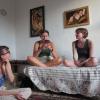Before moving to Siena for the summer, neither I nor the other students here really knew what the Palio was. I knew briefly from my father that it was a horse race in Siena that dates back centuries, but I had no idea what it entailed or what it meant to the people of Siena.
When I arrived at IES Abroad, I was able to sign up for the course The Palio and the Contrade of Siena (Contrade pronounced cone-trah-day, the plural of Contrada) with professor Anna Piperato, who is a tour guide here in Siena and a Lupaiola, a member of the Lupa Contrada. In simple terms, a Contrada is a neighborhood in Siena. There are 17 Contrade, all represented by a different animal, who run almost like an individual city—with their own Priore and Capitana, the leaders of the Contrada during peace and war (Palio) times, respectively. The Sienese are extremely passionate about their Contrade and very proud of the Contrada they are from. I don’t think I have ever experienced a passion for a place and a culture as much as anyone from Siena. Only ten Contrade race in each Palio for safety, but even the members of the Contrade that aren’t running are there in the Piazza del Campo, watching with excitement and angst.
I wasn’t sure what to expect at any of the Palio events, but as I kept learning about the process and going to the events I became more and more excited. Even after hearing about the setup of the Piazza del Campo, I couldn’t quite picture what the actual physicality of the race would look like. It was kind of like magic when I walked into the Piazza the day they put the tufo (the sand that the horses race on) down because it seemed like it just appeared out of nowhere.
I went to the first Night Trial, and seeing so many people in the Piazza with the horses at dawn was really exhilarating even though I was very exhausted and didn’t get much sleep. My Italian roommate, Stefania, stayed up all night with her friends to wait for the Night Trial and I got to see her there and hear about her party (even though she was sick). It was really cool to see how fun and important the Palio was even to her, who hasn't been living in Siena for very long.
In the Palio’s history, the Night Trial was not official. “Night Trial” used to refer to when the horse jockeys (before they had officially agreed to run for any Contrada) would sneak onto the piazza at two or three in the morning to practice running the horses. Once the people of Siena found out about these Night Trials, many of them would stay up late to watch them. Eventually it became a part of the official Palio events. Now, the Night Trials start at 5:30 A.M. in the days leading up to the Prima Prova, the first official trial race after the horses were assigned to each Contrada.

After these events started, I got more into the mindset of the Palio by trying to memorize all of the horses that could run and look into the information on some of the potential jockeys. My friend, Elke, and I started our Contrada cards (an assignment for Palio class that consisted of us writing down each Contrada, their symbol, colors, lucky number, main street, trade, rival, etc.) that weekend and we ended up doing a whole deep dive into the archives of every Palio—seeing which Contrade ran at each, who won, on what horse, with what jockey, if there were any unusual circumstances, etc. (like this July the Palio was delayed two days because of rain).
The day of the Prima Prova also consists of the last unofficial trial and the drawing of the horses, so, of course, I went to each event. It was not pleasant in the ninety-three degree midday heat, but it was fun watching the Sienese people move with the shadow of the Palazzo Pubblico tower on the Piazza. Elke and I were rooting for horse number thirty-five in the selection because (we think) that was the horse that knocked off its rider in the first Night Trial and ran at least seven more laps around the Piazza because it felt free. The other riderless horses that day seemed spooked, but number thirty-five seemed very happy to be running around by itself.
When it was time for the horse selection—the “Estrazione”—you could hear the buzz of each Contrada waiting to see which horse they would get. It was especially anxiety inducing considering there were so many horses that hadn’t raced in the Palio before. I remember the Contrada Valdimontone’s cheers for the horse, Ungaros, the most. My friends and I heard a loud murmur come across the Piazza as soon as Ungaros was called, and then when Valdimontone was called next, there were loud cheers and we saw a sea of pink fazzoletti (the silk square scarves that each Contrada wears tied around their shoulders) rushing around us to greet Ungaros. It was so surprising and moving to watch. Later that night I got so many great pictures of the Prima Prova on my fancy camera—my professor took us up to her friend’s tower, so we had an amazing view. The Prima Prova is the first official trial, when each Contrada knows which horse and jockey they have. Between the Estrazione there are six trials, and in each the horses are lined up in a different order, and the race is structured like the actual Palio race.

The (first) day of the Palio pretty much all of the IES Abroad students were excited to watch, and again it was thrilling to just be near so many contradaioli and hearing them berate tourists for having their phones out during the Mossa (when the horses get lined up). And that day we could actually eat on the Piazza! We all were waiting in the Piazza since around 4 P.M., and I forgot a book, so I felt like a bored dad that needed something to do, so I went over to Nice and got some gelato and accidentally dripped it on the back of the Italian guy sitting in front of me (he didn’t notice). When we were so crowded that we had to stand, we met a young (French?) woman who had just moved to Siena in the past year. She was very excited to see her first Palio and explained some things to us about it (she didn’t know that we were already experts).
With each Palio day, we all became more excited, even when two of them ended with us all drenched in rain and covered in tufo turned to mud. But now we could actually make predictions of who would win because it is so rare to have the Palio delayed two days due to rain. Elke and I looked up the Contrade lucky numbers and created some very detailed conspiracies (even though they were wrong—it’s fine). And finally the Palio actually happened!! This day we were surrounded by the Nicchio, Onda, and Oca Contrade, and with the way the race turned out at the last second, we could perfectly see Onda’s excitement and Oca’s astonishment and anger (Onda won with Oca in second, meaning they were humiliated). We were able to see a little of Brigante, Onda’s jockey, and Tabacco, Onda’s horse, being celebrated, but it was a crazy rush, and we were able to see it much better in the videos we watched in class. Later we were able to see Onda with pacifiers tied to their fazzoletti, which symbolized rebirth!
Overall it was such an amazing experience. I am filled with awe at how much pride and passion the Sienese have for the Palio and the Contrade, and I am truly so happy that I was able to experience a piece of that with them. I hope that one day I’ll be able to come back and get to experience it again, and keep up with the horses and jockeys more.

Gemma Colasanti
Hi! My name is Gemma and I study writing, Italian, and live event management at Ithaca College. When I'm not at dance class, you can find me reading, crafting, thrifting, and snuggling with my cats, Lyra and Tiny.






